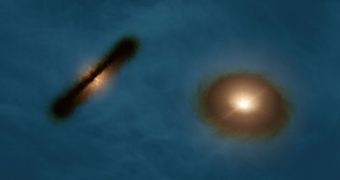A paper published in yesterday's issue of the journal Nature announces the discovery of two fairly odd planet-forming discs around stars in a binary system known to the scientific community as HK Tauri.
According to researchers with the European Southern Observatory (ESO), this binary system is located at a distance of about 450 light-years from our planet, in a constellation that goes by the name of Taurus.
The two stars that comprise this system, i.e. HK Tauri A and HK Tauri B, are estimated to be less than 5 million years old. This means that, when compared to other celestial bodies of this kind, they are fairly young.
As detailed in the journal Nature, HK Tauri A and HK Tauri B, which sit at a distance of about 58 billion kilometers (about 36 miles) from one another, both have a planet-forming gas disc around them.
To study the discs, astronomers with ESO resorted to ALMA (the Atacama Large Millimeter / submillimeter Array), an array of telescopes in the Atacama desert in northern Chile that works by observing wavelengths.
It was thus discovered that the protoplanetary discs around the two stars in the binary system HK Tauri were oddly misaligned. Hence, it is believed that the planets they will eventually come to form will have rather peculiar orbits.
In a press release concerning this investigation and its outcome, ESO specialists detail that, instead of being in the same plane as the orbits of HK Tauri A and HK Tauri B are, the two discs are out of alignment with each other by approximately 60 degrees.
“If the two stars and their discs are not all in the same plane, the gravitational pull of one star will perturb the other disc, making it wobble or precess, and vice versa. A planet forming in one of these discs will also be perturbed by the other star, which will tilt and deform its orbit,” astronomers say.
Writing in the journal Nature, ESO astronomers argue that, all things considered, this investigation into the anatomy of the binary system HK Tauri might help explain why it is that many of the planets that have until now been discovered outside our solar system have peculiar orbits.
“Our results show that the necessary conditions exist to modify planetary orbits and that these conditions are present at the time of planet formation, apparently due to the formation process of a binary star system,” explains astronomer Eric Jensen.
Scientists wish to carry out further investigations and hope that they will soon be able to determine whether such misalignments are a common sight in out Milky Way and in other galaxies, or if maybe HK Tauri's appearance is no more and no less than a remarkable individual case.

 14 DAY TRIAL //
14 DAY TRIAL //